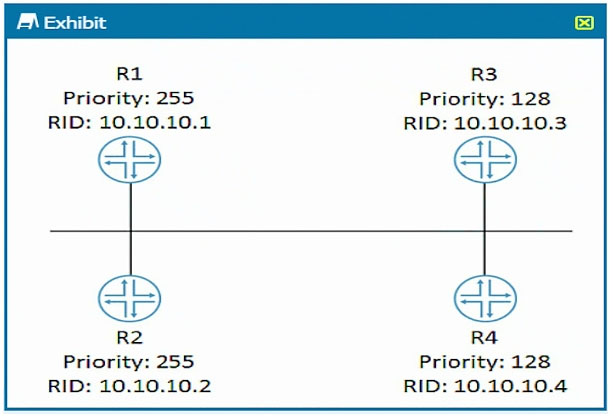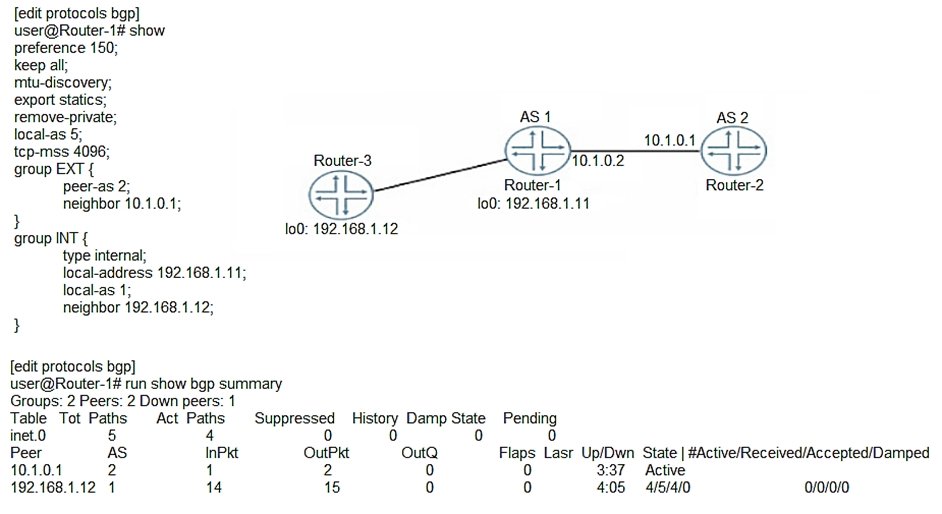Enterprise Routing and Switching, Specialist v1.0
Question 1
Which device is used to separate collision domains?
- A. switch
- B. router
- C. hub
- D. firewall
Answer : A
Question 2
What is the default BGP group type on a Junos device?
- A. internal
- B. external
- C. multihop
- D. null
Answer : B
Question 3
In which two STP states is a port active and a MAC address learned? (Choose two.)
- A. blocking
- B. forwarding
- C. disabled
- D. learning
Answer : BD
Question 4
You are enabling dynamic ARP inspection on an EX4300 switch.
Which service is enabled by default in this scenario?
- A. DHCP snooping
- B. persistent MAC learning
- C. MAC limiting
- D. IP Source Guard
Answer : A
Question 5
Which two sequences correctly describe the processing order of firewall filters on an EX Series switch? (Choose two.)
- A. router filter > VLAN filter > port filter > transmit packet
- B. port filter > VLAN filter > router filter > transmit packet
- C. receive packet > port filter > VLAN filter > router filter
- D. receive packet > router filter > VLAN filter > port filter
Answer : AC
Question 6
Which statement is true when using LAGs with an EX4300?
- A. Speeds on member links can differ.
- B. Member links must be contiguous.
- C. Half duplex is supported on the LAG.
- D. You can have up to 16 member links per LAG.
Answer : D
Question 7
How many bytes of overhead are added to a packet traversing a GRE tunnel?
- A. 20
- B. 24
- C. 12
- D. 16
Answer : B
Question 8
You added a new ESXi host connected to port ge-0/0/1. One of the VMs configured with VLAN 10 is not reachable from any other device on the switch. To troubleshoot, you decide to verify if the VM"™s MAC address is learned properly under VLAN 10.
Which command would you use in this scenario?
- A. show ethernet-switching table vlan-id 10
- B. show interfaces ge-0/0/1 detail
- C. show vlans 10
- D. monitor interface ge-0/0/1
Answer : A
Question 9
You are adding a new EX4300 member switch to your existing EX4300 Virtual Chassis. However, the new member is not running the same Junos version as the other members.
By default, what is the expected behavior in this scenario?
- A. the Virtual Chassis will transition into a split brain situation between the existing master Routing Engine and the switch running the different version.
- B. The new switch will automatically pull the correct version from the master Routing Engine and perform the necessary upgrade.
- C. The new switch will be assigned a member ID and then placed in an inactive state.
- D. The new switch is not recognized by the Virtual Chassis.
Answer : C
Question 10
What are the three possible port states when using RSTP? (Choose three.)
- A. forwarding
- B. learning
- C. discarding
- D. listening
- E. tagging
Answer : ABC
Question 11
What are two characteristics of IS-IS CSNPs? (Choose two.)
- A. IS-IS CSNPs contain header information for all link-state PDUs.
- B. IS-IS CSNPs are used to request a copy of a missing link state PDU.
- C. IS-IS CSNPs are used to maintain the link-state database synchronization.
- D. IS-IS CSNPs contain header information for specific requested link-state PDUs.
Answer : AC
Question 12
What are two methods for reducing the size of an OSPF link-state database? (Choose two.)
- A. Use unique router IDs where possible.
- B. Use identical link metrics where possible.
- C. Use point-to-point interface types where possible.
- D. Use stub areas where possible.
Answer : CD
Question 13
Click the Exhibit button.

Referring to the exhibit, which router becomes the OSPF DR when all routers are powered on at the same time?
- A. R3
- B. R4
- C. R1
- D. R2
Answer : D
Question 14
Click the Exhibit button.

Based on the output shown in the exhibit, which statement is correct?
- A. This switch has been elected as the root bridge
- B. This switch has a bridge priority of 32k
- C. The ge-0/0/15 interface is using the default port cost
- D. The ge-0/0/9 interface is using the default priority value
Answer : A
Question 15
Click the Exhibit button.

Referring to the exhibit, Router-1 is attempting to form an EBGP session with Router-2. However, BGP routes are never exchanged between Router-1 and
Router-2.
What is causing the problem?
- A. The TCP-MSS value is set too low
- B. The EXT group is not configured as an external type BGP peering session
- C. The EBGP session is configured to use the wrong AS
- D. The keep all statement is preventing the session from establishing
Answer : B